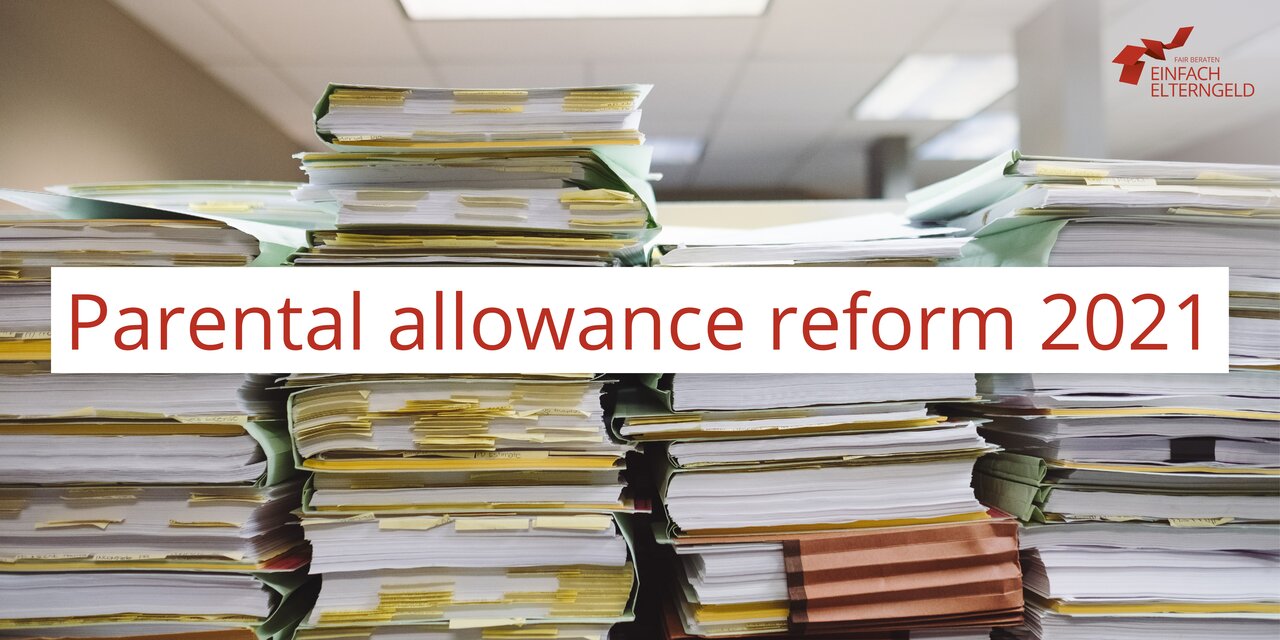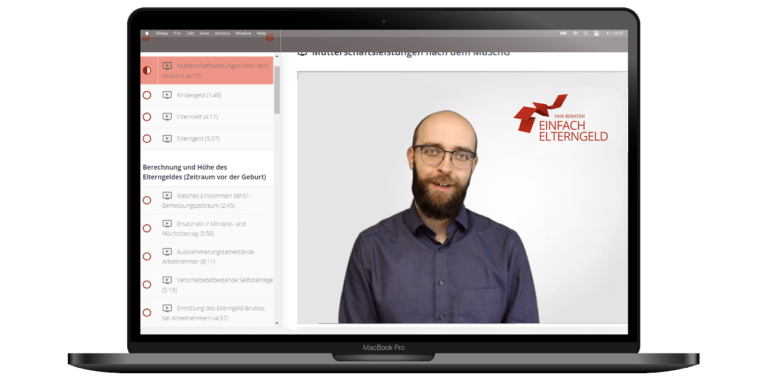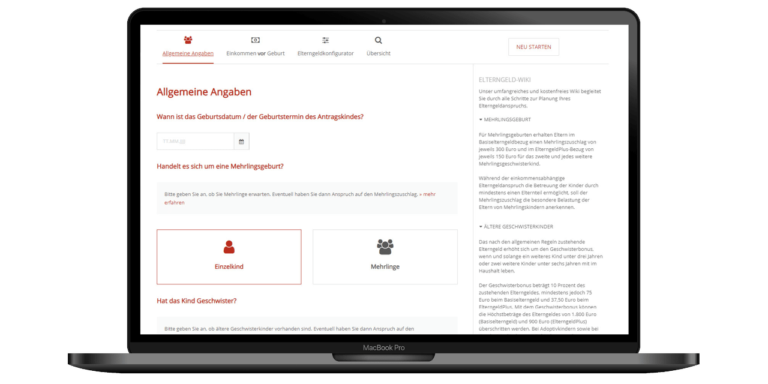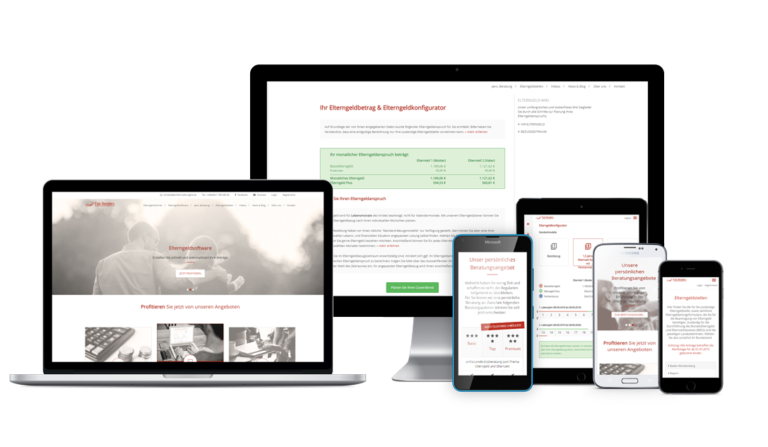Parental allowance - new regulations from 01.09.2021

On September 16, 2020, the Federal Ministry for Family Affairs, Senior Citizens, Women and Youth under former Dr. Franziska Giffey introduced a draft law in connection with parental allowance in the Federal Cabinet, which was passed on the same day. This article is dedicated to the content of the law and its implications for parents.
Here are the most important facts about the law:
- The new regulations only apply to parents whose children were born on or after 01 September 2021
- The maximum weekly working hours while receiving parental allowance was increased to 32 hours per week
- Parents of preemies will be better off
- Partnership bonus months become more attractive
- Non-self-employed persons may waive exclusion criteria
- Test of the most favorable assessment period for parents with mixed income was introduced
- Parental allowance plus is now only eligible until month of the life 32
- Subsequent verification obligations do not apply
- Parents with a taxable income of more than €300,000 are no longer eligible for parental allowance
From when do the new regulations apply?
The changes apply to parents whose children were born on or after September 01, 2021.
This article sheds light on the new law, which was already approved as a draft bill by the federal cabinet on September 16, 2020.
Notice:
Parents whose children were born before September 01, 2021 are not affected by the new regulations. There is no right to choose between the two legal situations.

New maximum working time of 32 hours per week
One of the basic requirements for receiving parental allowance is that you do not work full time while receiving parental allowance. Until now, this was fulfilled if one was not employed for more than 30 hours per week on average per month of life.
As a result of the amendment to the law, this limit has now been increased to 32 hours per week on average over a lifetime. The reason for this is mainly an extended flexibilization of employment while receiving parental allowance, because this now also makes a 4-day week possible.
Introduction of extra months for parents of premature babies
The new provision in Section 4 (5) Sentence 1 and Sentence 2 BEEG establishes a new statutory entitlement for parents to an additional basic parental allowance month or to two additional parental allowance plus months, provided that the child in question was born at least six weeks before the expected date of delivery. The calculation is based on the expected date of delivery as shown by the medical certificate or the certificate of a midwife or maternity nurse analogous to Section 3 (1) sentence 3 of the Maternity Protection Act.
Example:
Expected date of delivery on 28.12.2021 / birth on 15.11.2021.
In this case, the parents can apply for 15 months of basic parental allowance together, the maximum division is 13-2. Basic parental allowance in the 15th month of the life is thus possible.
Notice:
Due to the birth of a child well before the expected date, maternity leave is generally extended. Mothers who receive maternity leave payments (e.g. from their health insurance fund, employer, etc.) in these cases must apply for basic parental allowance for all months of the child’s life during which they receive maternity leave payment. The maternity leave payment is offset against the basic parental allowance.

Example
Expected date of delivery on 28.12.2021 / birth on 15.11.2021.
In this case, the maternity leave of the compulsorily insured, employed mother lasts up to and including 21.03.2022 (provided that the premature baby weighed less than 2,500g). As a result, the mother receives maternity leave payments until the 5th month of life (=15.03.2022 to 14.04.2022). This means that she must choose basic parental allowance for at least the first five months of her life out of a maximum of 13 possible basic parental allowance months and may not receive any parental allowance for this period, as the maternity leave payment is generally higher than the basic parental allowance entitlement.
Notice:
Correctly, the exclusion criteria were also expanded in the new law due to the “preemie month”. This means that in the cases concerned, calendar months of the 15th month of life can now also be excluded if parental allowance was drawn for older siblings (who were “premature babies”) up to the 15th month of life, see Section 2b (1) sentence 2 no. 1 (new version).

Update as of January 29, 2021:
The Bundestag has passed an even better regulation for parents of premature babies in the second and third reading than initially planned. According to this, the parents’ joint entitlement to basic parental allowance for a child born
- was born at least 6 weeks before the expected date of delivery: 13 monthly amounts of basic parental allowance;
- was born at least 8 weeks before the expected date of delivery: 14 months’ basic parental allowance;
- was born at least 12 weeks before the expected date of childbirth: 15 months’ basic parental allowance;
- was born at least 16 weeks before the expected date of childbirth: 16 months’ of basic parental allowance.
For the calculation of the period between the expected day of childbirth and the actual day of childbirth, the expected day of childbirth is relevant, as it results from the medical certificate or the certificate of a midwife or a maternity nurse.
The new partnership bonus months
One of the most effective media changes involves the partnership bonus months. That a change was needed here is also shown by the parental allowance statistics, because in 2019 only 1.85% of parents applied for the partnership bonus months1.
To increase the attractiveness of the partnership bonus months, the federal government responded with the following changes:
Parents who now wish to apply for the partnership bonus months must
- at least 2, maximum 4 consecutive months of the life
- parallel (i.e. both parents at the same time)
- be employed part-time for a minimum of 24 hours per week and a maximum of 32 hours per week on a monthly average.
Those who meet these requirements receive additional parental allowance plus months for each month of the bonus. In addition, the law takes into account that if it subsequently becomes known that the requirements were not met in one of the months of the child’s life, the entire bonus is no longer forfeited, but only the parental allowance plus for the month in question must be repaid. Any gaps in parental allowance that may arise as a result remain irrelevant for subsequent parental allowance payments.
Personal opinion:
The amended law is a step in the right direction. However, the regulations surrounding the partnership bonus are still far too complex. Treating it as a parental allowance plus month and not as a separate type of entitlement still creates great potential for error with regard to expectations about the amount of the bonus.
In addition, the bonus is currently still not really lucrative financially, because parental allowance plus is usually already significantly reduced for a part-time income of 24 hours. In particular, parents who draw the maximum amount of parental allowance remain disadvantaged by the capping of the net prenatal parental allowance at €2,770.
A spin-off of the bonus as an independent type of entitlement with a higher minimum amount and a removal of the “maximum amount cap” would be our recommendation to make the partnership bonus more lucrative. On the other hand, the exception rule that a subsequent elimination of the requirements no longer leads to a complete elimination of the bonus is very positive for the parents.
1 reference: Statistisches Bundesamt,Elterngeldbezüge nach Bundesländern, Jahresergebnisse, 2019 (https://www.destatis.de/DE/Themen/Gesellschaft-Umwelt/Soziales/Elterngeld/Tabellen/liste-leistungsbezuege-elterngeld-jahre.html)
– as of: 01.10.2020
Waiver of exclusion for non-employed persons
Employed parents who are worse off in terms of parental allowance due to the mandatory exclusion than without the exclusion may waive the exclusion criteria again under the amended law. This was already possible until the beginning of 2018 and was changed to the disadvantage of the parents due to a change in the constant Federal Social Court case law.
The change is to be welcomed, although it has made parental allowance law somewhat more complicated, as it should result in more comparative calculations.
Example:
Start of maternity leave 12/31/2021 / birth on 02/08/2022
The calendar months (December 2021 and January 2022) of the maternity leave of the compulsorily insured, employed mother would be excluded according to the old mandatory rules. Accordingly, the assessment period would be December 2020 up to and including November 2021. Assume that the mother’s gross income relevant for parental allowance was €3,000 per month in the months December 2020 to June 2021. In July, the mother received a salary increase to 3,250€. Now, in December 2021, she receives a pro rata share of €3,145 in gross income relevant for parental allowance (30/31).
If she waives the exclusion of the calendar month December 2021, she will receive a higher parental allowance. This effect is even more significant if the income at the beginning of the assessment period would have been significantly lower (e.g. if the mother had still been a student or trainee). Employed parents should therefore always check whether it would make more sense for them to waive the exclusion criteria.
Test of the most favorable assessment period for parents with mixed income to be introduced
Under the new law, parents who are employed and earn a “small amount” of part-time profit income will be able to choose whether they want to be treated solely as employees or as self-employed for the purposes of calculating parental allowance.
The following requirements must be met for this test of the most favorable assessment period:
- The income (= profit) from self-employment, business or agriculture and forestry in the calendar year before the birth
- and in the calendar months of the year of birth until birth
not more than 35€ per month (average, that is 410€ per calendar year).
Example:
Birth on 08.10.2022 – Mother is employed and self-employed. Normally her assessment period would be the calendar year 2021. Now the profit from self-employment in 2021 was “only” 400€ and in the period January to September 2022 “only” 200€. The mother can now choose whether she wants to use the calendar year 2021 (January to December 2021) as the assessment period or the 12-month period before the start of maternity leave or before the birth (i.e. October 2021 to September 2022).
If she chooses the former option, the employee income from January to December 2021 and the profit of 400€ will count in the parental allowance calculation. However, if she chooses the 12-month period before birth, only her employee income counts. The self-employed income is ignored, so to speak. The parents concerned should therefore check in any case which variant entails the higher parental allowance.
Personal opinion:
We expressly welcome the new test of the most favorable assessment period, because many parents will achieve a higher parental allowance as a result. Nevertheless, the change in the law is an enormous complication of the parental allowance law. Parents will not be able to determine the best assessment period for themselves without detailed advice and concrete calculations. Furthermore, the limit of €35 per month on average does not go far enough for us. It is understandable that the limit is based on the tax-free limit, but the limit should be increased in the interests of the parents.
We see problems in the fact that the requirements can already be definitively proven by preliminary profit determinations, even if a different result is reached in the subsequent tax assessment (Section 2b (4) sentence 4 n.F.). The administrative simplification is obvious, but the doors are open for manipulations. Conversely, subsequent changes to notices will probably no longer be possible if parents assume that they are above the limit, but the year-end entries fall below the limit. The extent to which a change is then still possible is not yet clear from the law, and the restriction regulation suggests that a correction of the parental allowance notice should no longer be possible. What on the one hand is supposed to give parents legal certainty, on the other hand gives rise to quite a bit of legal uncertainty.
In addition, we do not understand why vertical loss offsetting should be possible. For example, negative income from a commercial enterprise is offset against positive income from self-employment or from agriculture and forestry in order to get below the limit of 410€. Since there is the vertical loss compensation otherwise also not in the parental allowance right, this represents in our opinion a system break and results in consequence logic error in the parental allowance right.
All parents, especially those with several types of income and losses in individual businesses, will have to carefully examine which assessment period is best for them.
Reduction of reference months with parental allowance plus
What the media has not taken up at all about the change in the law is the now legal limitation of the parental allowance up to the 32nd month of the child’s life. Previously, it was possible to receive parental allowance up to a maximum of 46 months of life, but only if the child was born in month 15 and the partnership bonus months were used. In the completely revised § 4 BEEG, here in paragraph 1 sentence 4, a maximum reference period for parental allowance plus was explicitly introduced, which in our opinion can be a disadvantage for parents, although the actual cases in which parents receive parental allowance for such a long time will be quite manageable.
Personal opinion:
The amendment represents a significant deterioration in parental allowance. We wonder whether this is an editorial oversight.
In particular, mothers who are affected by the breastfeeding employment prohibition will be worse off as a result of this regulation. You can find more information on this topic in our article “Breastfeeding employment prohibition (Still-BV) and parental allowance“.
Ease of burden of proof
The new Section 8 (3) Sentence 1 No. 4 BEEG n.F. stipulates that subsequent proof of the amount of time worked during the reference period no longer has to be submitted.
The main reason for this is that parents have an obligation to notify the employer in accordance with Section 68 (15) in conjunction with Section 60 (1) sentence 1 (2) of the First Book of the German Social Code (Erstes Buch Sozialgesetzbuch) anyway, which is why there is no longer any need for a separate, subsequent check. Those who violate their obligation to notify must in any case reckon with the corresponding consequences, possibly under the law on administrative offenses.
After all, the amendment serves to streamline the law, the formal requirement for parental allowance and the preparation of the completely digital application system for parental allowance.
Parents with above average income
Under the old law, taxable income in the calendar year before the child’s birth could not exceed €500,000 for parent couples. This limit was lowered to €300,00 in the current amendment. The Federal Ministry for Family Affairs (Familienministerium) stated in the draft that the limit was just under ten times the average taxable income among taxpayers with positive income. With such a high taxable income, it can be assumed that parental allowance is irrelevant for the decision on the extent to which gainful employment should be foregone in favor of caring for the child. Against this background, a reduction of the threshold amount for couples with a joint parental allowance claim was appropriate.
Other
Many other changes were made, but their content was not of a legal nature, but of an editorial clarifying nature. The following points were not taken into account in the current amendment and we still consider them to be in need of central improvement:
- Increase in minimum and maximum amounts, by at least the rate of inflation since 2007.
- Expansion of exclusion and postponement eligibility (inclusion of parental-only months, months of unaccrued earned income loss – in addition to Covid-19-eligible earned income loss)
- Partnership bonus months as an independent type of entitlement
- more extensive favorability tests for the choice of the assessment period
- Non-deduction of fictitious social security contributions from earnings income actually exempt from social security for parents with mixed incomes
- Consideration of miscellaneous and one-time payments for salaried employees
- Rewarding parental allowance plus (those who choose to receive parental allowance plus for a longer period should receive “extra months”)
Read more about this topic in our article “7 suggestions for improving parental allowance”.
You might also be interested in




